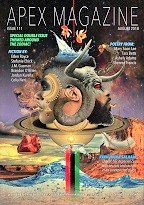“For Southern Girls When the Zodiac Ain’t Near Enough” by Eden Royce
Reviewed by Victoria Silverwolf
Guest editor Sheree Renée Thomas offers half a dozen stories inspired by the zodiac in this double-sized issue. In some cases, the influence is obvious; in others, subtle enough to be nearly undetectable.
“For Southern Girls When the Zodiac Ain’t Near Enough” by Eden Royce is written in second person present tense. You visit a fortune teller. She reads your future with a deck of cards. Instead of the familiar images of the Tarot, these depict things associated with the American South. Each card reveals something about yourself in a symbolic way. The main appeal of this simple story is the author’s evocative descriptions of Southern icons.
Twin sisters are the main characters in “Prism” by Stefanie Elrick. After the suicide of their mother, one runs off to Europe. The other, who is the narrator, remains behind. The runaway joins a rock band and is killed in a bizarre accident on stage. Her sister obtains her belongings. The narrator experiences the dead woman’s memories, revealing the truth about the tragic concert. The story ends in an ambiguously hopeful fashion. This dark fantasy is confusing at times. The most powerful scene is the flashback to what happened on stage.
“La Ciguapa, For the Reeds, For Herself” by J. M. Guzman involves a mythical being of the Dominican Republic. The ciguapa is a woman with very long, thick hair and backwards feet. In traditional legends, she lures men to their doom. In this case, however, she is a protector of abused women. This brief description hardly does justice to a complex, dense tale written in a difficult style. The author makes frequent use of unusual metaphors, detracting from the story’s clarity.
“Gasping” by Brandon O’Brien is written in an informal style with the flavor of the Caribbean. A married couple find a child on the beach and adopt her. She grows into an accomplished young woman and finds true love. Readers of fantasy will not be surprised by the transformation that follows. The author’s use of language makes a familiar plot enjoyable to read.
“Jewel of the Vashwa” by Jordan Kurella takes place in a fantasy world where an army of women is at war with scorpion men. However, the women often take the men as lovers, and raise the daughters they bear as warriors. The narrator is one such half-breed. She relates different versions of a violent encounter between the two peoples. Eventually she tells the truth, revealing much about her own character. This is a grim and violent sword-and-sorcery tale. Many readers will find it difficult to empathize with the protagonist.
“The Barnum Effect” by Celia Neri is this issue’s only science fiction story, although some aspects of it may seem fantastic. In the near future, the protagonist works on a project involving artificial intelligence. The AI provides astrological predictions for newspapers and phone apps, making use of stock phrases and vague generalities. For unknown reasons, the AI produces more of these predictions than it is supposed to. When a series of statements from the AI seem to relate directly to the scientist’s experiences, even saving her life, she becomes convinced that it has genuine precognitive powers. This is an interesting story, which provides no easy answers for the questions it raises. It contrasts the skepticism of science with the irrationality of human society, revealing how thin the line between them can be. The author writes in a clear, unadorned style, which makes some of the other stories in this issue look overwritten.
Victoria Silverwolf is an Aquarius who doesn’t believe in astrology.
 Apex #111, August 2018
Apex #111, August 2018